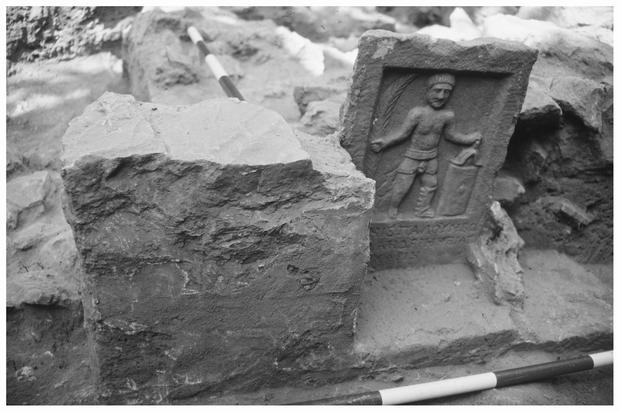Historic sources claimed referred to gladiators as "hordearii" ("barley eaters") because they had an inferior diet, heavy in beans and grains, the hallmark of poor status. Even 2,000 years ago people made fun of vegetarians, it seems. Though the diet was accurate, it was not all special, according to a new paper.
A new study by Medical University of Vienna and the University of Bern examined bones from a gladiator cemetery uncovered in 1993 which dates back to the 2nd or 3rd century BC in the then Roman city of Ephesos - modern-day Turkey. At the time, Ephesos was the capital of the Roman province of Asia and had over 200,000 inhabitants.

In situ gladiator tombstone excavated in the cemetery. doi:10.1371/journal.pone.0110489
Using spectroscopy, stable isotope ratios (carbon, nitrogen and sulfur) were investigated in the collagen of the bones, along with the ratio of strontium to calcium in the bone mineral. The result shows that gladiators mostly ate a vegetarian diet, virtually no different in terms of nutrition from the local "normal population".
Meals were meat-free, primarily grain. The tern "barley eater" relates in this case to the fact that gladiators were probably given grain of an inferior quality.
But there was one difference between gladiators and the normal population: the amount of strontium measured in their bones. The authors conclude that the gladiators had a higher intake of minerals from a strontium-rich source of calcium, meaning that the 'ash drink' quoted in literature probably really did exist.
"Plant ashes were evidently consumed to fortify the body after physical exertion and to promote better bone healing," says study leader Fabian Kanz from the Department of Forensic Medicine at the Medical University of Vienna. "Things were similar then to what we do today - we take magnesium and calcium (in the form of effervescent tablets, for example) following physical exertion."
Calcium is essential for bone building and usually occurs primarily in milk products.
Citation: Lösch S, Moghaddam N, Grossschmidt K, Risser DU, Kanz F (2014) Stable Isotope and Trace Element Studies on Gladiators and Contemporary Romans from Ephesus (Turkey, 2nd and 3rd Ct. AD) - Implications for Differences in Diet. PLoS ONE 9(10): e110489. doi:10.1371/journal.pone.0110489





Comments